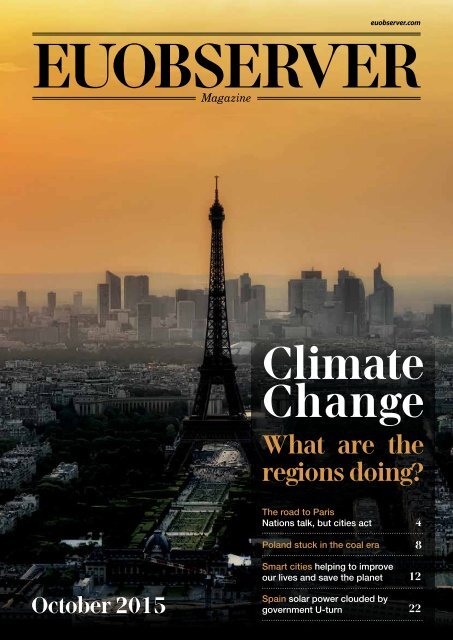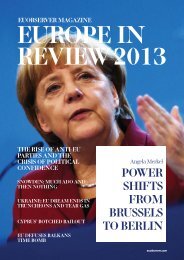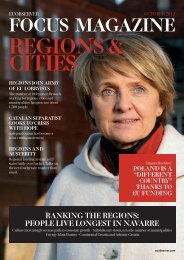Climate change: What are the regions doing?
The 2015 edition of EUobserver's Regions & Cities magazine focuses on climate change and what cities and regions are doing.
The 2015 edition of EUobserver's Regions & Cities magazine focuses on climate change and what cities and regions are doing.
Create successful ePaper yourself
Turn your PDF publications into a flip-book with our unique Google optimized e-Paper software.
euobserver.com<br />
Magazine<br />
<strong>Climate</strong><br />
Change<br />
<strong>What</strong> <strong>are</strong> <strong>the</strong><br />
<strong>regions</strong> <strong>doing</strong>?<br />
The road to Paris<br />
Nations talk, but cities act 4<br />
Poland stuck in <strong>the</strong> coal era<br />
8<br />
October 2015<br />
Smart cities helping to improve<br />
our lives and save <strong>the</strong> planet<br />
12<br />
Spain solar power clouded by<br />
government U-turn 22
euobserver<br />
I’ll walk<br />
By Peter Teffer<br />
EDITORIAL ADDRESS<br />
EUobserver Magazine<br />
Rue Belliard 18b<br />
1040 Brussels<br />
Belgium<br />
contact@euobs.com<br />
Editor<br />
Lisbeth Kirk<br />
Editorial contributors<br />
Peter Teffer, Nikolaj Nielsen, Paulina Pacula,<br />
Eric Maurice<br />
ARTICLE LAYOUT<br />
It is not a very Dutch thing to do, but I have given up on<br />
riding a bicycle in Brussels. I was already getting annoyed<br />
by <strong>the</strong> lack of dedicated cycle lanes, waiting behind car<br />
exhausts and being obliged to wear a reflective space suit<br />
and helmet, when <strong>the</strong> bike broke.<br />
I’ll walk.<br />
The unfriendly atmosphere that cyclists sometimes face in <strong>the</strong> European<br />
capital was illustrated earlier this year by a sadly hilarious video entitled<br />
‘Brussels Bike Jungle’.<br />
ADVERTISING<br />
EUobserver Magazine<br />
Rue Montoyer 18B<br />
1000 Brussels<br />
Belgium<br />
Filip Lugovic<br />
fl@euobs.com<br />
Daniele Castaldelli<br />
dc@euobs.com<br />
PRINT<br />
Drukkerij Van der Poorten<br />
DISTRIBUTION<br />
EUobserver Magazine<br />
Rue Montoyer 18B<br />
1000 Brussels<br />
Belgium<br />
Meg Chang<br />
mc@euobs.com<br />
PRICE PER COPY<br />
€4,75 + postage, excl vat / discounts<br />
on larger purchases<br />
PUBLISHER<br />
EUobserver.com ASBL<br />
www.euobserver.com<br />
MAKING SENSE OF THE EU<br />
EUobserver is an independent online newspaper<br />
which values free thinking and plain speech. We aim<br />
to support European democracy by giving people <strong>the</strong><br />
information <strong>the</strong>y need to hold <strong>the</strong> EU establishment to<br />
account.<br />
HIGH QUALITY JOURNALISM<br />
EUobserver is a non-profit organisation established<br />
in Brussels in 2000. It is financially and editorially independent<br />
of <strong>the</strong> EU institutions. Our team of experienced<br />
journalists file daily news reports from <strong>the</strong> EU capital and<br />
do in-depth investigations on topics of special interest. If<br />
you want EUobserver to look into a specific issue, please<br />
contact our editors. We protect our sources.<br />
Cover photo<br />
© Joe deSousa<br />
However, <strong>the</strong> situation may <strong>change</strong>: <strong>the</strong> Brussels Region has recently<br />
announced it will construct 80 kilometres of cycle lanes in <strong>the</strong> next three<br />
years. Which is not only good for spoiled Dutch cyclists, but also for <strong>the</strong><br />
world’s climate.<br />
All over Europe, cities and <strong>regions</strong> <strong>are</strong> introducing policies that have<br />
ei<strong>the</strong>r as a main goal, or a side-effect, a reduction of <strong>the</strong>ir greenhouse<br />
gas emissions. These gases <strong>are</strong> responsible for global warming, a<br />
phenomenon which, if not curbed, may make life a constant struggle for<br />
survival in those same cities and <strong>regions</strong>.<br />
Ahead of <strong>the</strong> all-important climate talks in Paris at <strong>the</strong> end of this year,<br />
many organisations and government layers <strong>are</strong> announcing <strong>the</strong>y will do<br />
<strong>the</strong>ir sh<strong>are</strong>: climate pledges <strong>are</strong> popping up left, right and centre.<br />
The Compact of States and Regions, which in Europe includes <strong>the</strong> Basque<br />
Country, Catalonia, Baden-Württemberg, Bavaria, Lombardy, Rhone-<br />
Alpes, Scotland and Wales, promised it would reduce CO2 emissions by<br />
7.9 gigatonnes by 2030 (<strong>the</strong> equivalent of <strong>the</strong> annual emissions of 2,000<br />
coal-fired power plants).<br />
When this magazine went to print, 4,821 mostly European cities and<br />
towns had submitted action plans as part of <strong>the</strong>ir membership of <strong>the</strong><br />
Covenant of Mayors.<br />
The Global Commission on <strong>the</strong> Economy and <strong>Climate</strong> calculated that<br />
with currently existing measures, by 2030, <strong>the</strong> world’s cities could reduce<br />
annual emissions by 3.7 gigatonnes of CO2-equivalent.<br />
Oh, and <strong>the</strong>y would save around €15 trillion between now and 2050.<br />
That should be enough for a couple of bike lanes.<br />
02 ––––– EUobserver Magazine 2015
PHOTOSSERIES<br />
How climate <strong>change</strong><br />
may affect Europe's<br />
cities and <strong>regions</strong><br />
Air pollution in Paris, 2013<br />
Photo: Damián Bakarcic<br />
Floods in eastern and sou<strong>the</strong>rn<br />
German states, 2013<br />
Photo: Michel Vorsprach<br />
Drought in Lake Constance<br />
Switzerland,<br />
2011<br />
Photo:Kecko<br />
Drought Wilberfoss, UK, 2012<br />
Photo: Keith Laverack<br />
Forest fires in Valenca in<br />
Portugal, 2010<br />
Photo: Elentir<br />
EUobserver Magazine 2015 ––––– 03
The road to Paris<br />
– nations talk but cities act<br />
The fight against climate <strong>change</strong> will be won or lost in <strong>the</strong> cities where most<br />
Europeans live and use most of all <strong>the</strong> energy produced in Europe.<br />
By Peter Teffer<br />
W<br />
hen Jean-Claude Juncker<br />
gave his first State of <strong>the</strong><br />
European Union speech<br />
in September, he spoke<br />
so long about migration<br />
that he had little time left<br />
to talk about <strong>the</strong> road to Paris.<br />
The president of <strong>the</strong> European Commission devoted<br />
just two of his ninety minutes on climate<br />
<strong>change</strong>. But from a text his civil servants distributed<br />
afterwards, we know what he had planned<br />
to say.<br />
“The fight against climate <strong>change</strong> will not be won<br />
or lost in diplomatic discussions in Brussels or in<br />
Paris”, Juncker said. “It will be won or lost on <strong>the</strong><br />
ground and in <strong>the</strong> cities where most Europeans<br />
live, work and use about 80% of all <strong>the</strong> energy<br />
produced in Europe.”<br />
Formally, local governments have no say in <strong>the</strong><br />
treaty that will be negotiated at <strong>the</strong> Paris <strong>Climate</strong><br />
Summit in December by <strong>the</strong> national representatives<br />
of 195 countries, plus <strong>the</strong> European Union<br />
(see box on page 6). However, cities and <strong>regions</strong><br />
will be involved in reaching <strong>the</strong> climate goals <strong>the</strong>ir<br />
national governments agree to – and some have<br />
already begun to do that.<br />
“The fight against<br />
climate <strong>change</strong><br />
will not be won or<br />
lost in diplomatic<br />
discussions in<br />
Brussels or in<br />
Paris”, European<br />
Commission<br />
president Jean-<br />
Claude Juncker<br />
said. “It will be<br />
won or lost on <strong>the</strong><br />
ground and in <strong>the</strong><br />
cities where most<br />
Europeans live”.<br />
Photo: ec.europa.eu<br />
04 ––––– EUobserver Magazine 2015
“As cities, we can lead <strong>the</strong> way in demonstrating<br />
innovative solutions. We can fight against climate<br />
<strong>change</strong>”, Karin Wanngard, <strong>the</strong> mayor of Stockholm,<br />
recently said at a conference organised by<br />
<strong>the</strong> Vatican.<br />
NATIONS TALK, BUT CITIES ACT<br />
Take Copenhagen, for example. Many involved in<br />
<strong>the</strong> climate dossier may associate <strong>the</strong> Danish city<br />
with <strong>the</strong> failed climate talks held <strong>the</strong>re in 2009.<br />
But <strong>the</strong> bike-friendly capital of 1.2 million may become<br />
an exemplar if it fulfills its promise of becoming<br />
completely carbon-neutral within <strong>the</strong> next<br />
ten years.<br />
Last year, when <strong>the</strong> city’s environment mayor visited<br />
Brussels, he told EUobserver that in his eyes “nations<br />
talk, but cities act”.<br />
“I see mayors, cities all around <strong>the</strong> globe actually<br />
acting in promoting more livable, greener and<br />
more sustainable cities, whereas I see nations<br />
just <strong>doing</strong> nothing, failing to act on what should<br />
have been <strong>the</strong>ir responsibility”, Morten Kabell said<br />
at <strong>the</strong> end of 2014.<br />
One year on, <strong>the</strong> list of cities and <strong>regions</strong> that have<br />
taken or promised action has only increased.<br />
Several cooperation agreements have been<br />
signed, such as <strong>the</strong> Covenant of Mayors, which,<br />
as of September 2015, has been signed by 5,887<br />
mayors of mostly European cities and municipali-<br />
Wind turbines in<br />
Denmark<br />
Photo: www.CGPGrey.com<br />
EUobserver Magazine 2015 ––––– 05
ties. Of <strong>the</strong>m, 80 percent submitted an action plan.<br />
While this does not yet mean that promises will be<br />
fulfilled, it at least shows that saving energy and<br />
increasing <strong>the</strong> sh<strong>are</strong> of renewable energy is on <strong>the</strong><br />
agenda of local governments.<br />
Regions <strong>are</strong> also involved in a similar scheme, with<br />
<strong>the</strong> initial results of commitments made by <strong>the</strong> socalled<br />
Compact of States and Regions expected<br />
to be presented in December in Paris. Members<br />
include Lombardy, Wales, Catalonia, Rhone-Alpes,<br />
and Baden-Württemberg.<br />
UK), and Oerebro (Sweden) have already promised<br />
<strong>the</strong>y will no longer hold any sh<strong>are</strong>s in oil,<br />
coal, or gas projects. And while a place like Boxtel<br />
has only 30,000 inhabitants, <strong>the</strong> cliched ‘every<br />
part helps’, was <strong>the</strong> message at a recent conference<br />
on fossil fuel divestment in Paris.<br />
“<strong>Climate</strong> <strong>change</strong> is an easy topic to feel powerless<br />
about. It’s easy to throw your hands up”, said<br />
Julia Christian, who was involved in a divestment<br />
campaign at a university faculty in London. “But<br />
it has to be now, it has to be us.”<br />
DIVESTMENT MOVEMENT<br />
The latest emerging trend that is starting to trickle<br />
down in city halls is <strong>the</strong> global “divestment” movement.<br />
Slowly but surely, European cities <strong>are</strong> also<br />
joining this camp, which started in American universities<br />
and urges investors to ditch <strong>the</strong>ir investments<br />
in fossil fuel projects, and reinvest that money<br />
in clean energy projects.<br />
Boxtel (<strong>the</strong> Ne<strong>the</strong>rlands), Oxford and Bristol (<strong>the</strong><br />
WHAT ARE THE CLIMATE NEGOTIA-<br />
TIONS IN PARIS ABOUT?<br />
From 30 November to 11 December 2015, <strong>the</strong><br />
French capital will host <strong>the</strong> United Nations’ 21st annual<br />
conference on climate <strong>change</strong>. These meetings<br />
<strong>are</strong> officially called Conferences of <strong>the</strong> Parties, or<br />
COP. Hence <strong>the</strong> acronym COP21. Not every COP is<br />
equally important, but this is a big one.<br />
There has been only one treaty that set binding<br />
targets for countries to attempt to reduce greenhouse<br />
gas emissions. The Kyoto Protocol (signed at COP3<br />
in 1997) only set binding goals for <strong>the</strong> richest countries<br />
in <strong>the</strong> world.<br />
The US never ratified it, it has been criticised for not<br />
being effective enough, and it expired in 2012. Countries<br />
were supposed to have signed a successor<br />
treaty at COP15 in Copenhagen, Denmark (2009),<br />
but that conference is widely seen as a failure, since<br />
it only produced a weak text.<br />
Paris is supposed to set right what was not achieved<br />
in Copenhagen: a global treaty with all countries, that<br />
commits <strong>the</strong>m to reducing greenhouse gas emissions.<br />
Ideally, <strong>the</strong> total of commitments would reduce emissions<br />
in such a way that <strong>the</strong> increase in <strong>the</strong> average<br />
global temperature - currently at 0.8 degrees Celsius<br />
higher since <strong>the</strong> mid-nineteenth century - does not<br />
rise above two degrees. However, <strong>the</strong>re <strong>are</strong> already<br />
signs that this may prove difficult to achieve.<br />
Countries were supposed to have signed a successor<br />
treaty at COP15 in Copenhagen, Denmark (2009), but that<br />
conference is widely seen as a failure, since it only produced<br />
a weak text.<br />
Photo: greenpeace.org<br />
06 ––––– EUobserver Magazine 2015
THE SMART<br />
DESTINATION<br />
FOR 2016.<br />
Welcome to Nordic Edge Expo 2016 – Nor<strong>the</strong>rn Europe’s<br />
most important <strong>are</strong>na for knowledge ex<strong>change</strong> and inspiration<br />
to creators of smarter cities and smarter homes.<br />
Come join us and you will meet forward-thinking city leaders,<br />
business managers, entrepreneurs, politicians, administrators<br />
and subject-matter experts from a wide range of companies,<br />
industries and countries.<br />
STAVANGER, NORWAY<br />
OCTOBER 6-7TH 2016<br />
nordicedgeexpo.com
Poland’s love affair<br />
with coal won’t end<br />
anytime soon<br />
The coal-based energy sector puts Poland in <strong>the</strong> position of 22nd most<br />
air-polluting country in <strong>the</strong> world, but <strong>the</strong> industry provides a livelihood<br />
for hundred of thousands of people in Upper Silesia and has <strong>the</strong> potential<br />
to swing elections.<br />
By Paulina Pacula<br />
Around 70 percent of Poland’s 5.5 million households warm up<br />
<strong>the</strong>ir houses using coal installations – simply by using ovens.<br />
Photo: Edgar Zuniga<br />
EUobserver Magazine 2015 ––––– 08
In <strong>the</strong> small Polish town of Brzeszcze, part of<br />
<strong>the</strong> Upper Silesian coal basin, almost half of <strong>the</strong><br />
21,000 inhabitants depend on one employer: <strong>the</strong><br />
KWK Brzeszcze mine, which is soon to be closed.<br />
More <strong>the</strong>n 2,000 men stand to lose <strong>the</strong>ir jobs because,<br />
for <strong>the</strong> last couple of years, <strong>the</strong> mine has been unprofitable<br />
– for every tonne of coal sold, <strong>the</strong> company had to<br />
pay 265 zlotys extra.<br />
If <strong>the</strong> mine is closed, unemployment in <strong>the</strong> municipality<br />
will skyrocket from its already-high level of 11.6%.<br />
A similar fate probably awaits ano<strong>the</strong>r 11,000 workers<br />
from unprofitable mines run by <strong>the</strong> biggest state mining<br />
company, Kompania Węglowa and 3,000 from JSW.<br />
“The situation in <strong>the</strong> mining sector is tragic and we <strong>are</strong><br />
fighting to keep our livelihoods”, Roman Brudzinski,<br />
head of <strong>the</strong> JSW miners’ union, told EUobserver.<br />
Aleksander Sniegocki, an energy market and climate<br />
expert from <strong>the</strong> Warsaw Institute for Economic Studies,<br />
said that during <strong>the</strong> period of 2010 until 2013, <strong>the</strong><br />
Polish government pumped 22 billion zlotys into <strong>the</strong><br />
mines in <strong>the</strong> form of state subsidies.<br />
Poland is not only paying extra for every tonne of coal<br />
produced in its mines, but <strong>the</strong> industry itself does not<br />
add anything to <strong>the</strong> country’s GDP growth.<br />
results: we export only 10 million tonnes per year and<br />
[we] import [a] similar amount so <strong>the</strong> balance is zero,”<br />
Sniegocki said.<br />
Due to technological underdevelopment, <strong>the</strong> productivity<br />
of Polish mines is very low, with 648 tonnes of<br />
coal produced per worker per year while in <strong>the</strong> worst<br />
US mines it is more <strong>the</strong>n 2,000 tonnes.<br />
In <strong>the</strong> biggest state-owned coal companies - Kompania<br />
Węglowa and JSW - labour costs constitute 50%<br />
of operating costs (comp<strong>are</strong>d to <strong>the</strong> privatised and<br />
profitable Bogdanka mine, where operating costs <strong>are</strong><br />
around 20%).<br />
So why <strong>are</strong> politicians so eager to keep <strong>the</strong> coal industry<br />
alive?<br />
Dariusz Jabłoński, a political scientist from Warsaw<br />
University, told EUobserver: “[The] Polish coal industry<br />
employs around 104,000 people mainly in one region:<br />
Upper Silesia. Ano<strong>the</strong>r 208,000 people <strong>are</strong> on<br />
miners’ pensions. Adding on those who <strong>are</strong> financially<br />
dependent on <strong>the</strong>m we get to around 500,000 active<br />
voters.”<br />
“This is <strong>the</strong> reason why instead of <strong>the</strong> debate about<br />
climate goals before <strong>the</strong> Paris summit, Poland has a<br />
debate on how EU goals to cut CO2 emissions threatens<br />
<strong>the</strong> country’s economic interest,” Jablonski added.<br />
“The profitability of this industry is much lower than any<br />
o<strong>the</strong>r sector. The coal also doesn’t count in <strong>the</strong> export<br />
Poland, along with Bulgaria, <strong>are</strong><br />
<strong>the</strong> countries with <strong>the</strong> worst air<br />
quality in <strong>the</strong> EU.<br />
Photo: Boguez Bilewski<br />
EUobserver Magazine 2015 ––––– 09
Today, <strong>the</strong> coal-based energy sector puts Poland<br />
in <strong>the</strong> position of 22nd most air-polluting country<br />
in <strong>the</strong> world.<br />
Photo: GrueneNRW<br />
COAL-BASED ENERGY SECTOR<br />
A strong workers union lobby, in combination with<br />
coal’s large sh<strong>are</strong> of Poland’s energy mix <strong>are</strong> <strong>the</strong> reasons<br />
why Polish politicians <strong>are</strong> so reluctant towards<br />
decarbonisation plans.<br />
According to Eurostat data, around 83% of energy<br />
consumed in Poland is produced from black and<br />
brown coal, while in <strong>the</strong> rest of <strong>the</strong> EU 28, <strong>the</strong> average<br />
is 28%.<br />
Only around 10% comes from renewables (<strong>the</strong> EU<br />
28 average is twice as high, at 20,4%) and only 4%<br />
comes from natural gas and oil (while in <strong>the</strong> rest of <strong>the</strong><br />
EU 28 it is 25%).<br />
The problem with gas and oil is that 90% of it is imported<br />
from Russia.<br />
Changing <strong>the</strong>se figures will be both expensive and<br />
time consuming. According to <strong>the</strong> long-term energy<br />
security strategy adopted two years ago by Donald<br />
Tusk’s government, coal will remain Poland’s main<br />
energy source until at least 2030 and will slowly be replaced<br />
by renewables, nuclear power and shale gas.<br />
ald Tusk decided to extend <strong>the</strong> Opole Plant by building<br />
ano<strong>the</strong>r two coal blocks. Large investments have also<br />
been made in <strong>the</strong> Turów, Kozienice and Stalowa Wola<br />
plants.<br />
Polish politicians claim that coal plants can also produce<br />
clean energy.<br />
“To reach emission goals we don’t have to resign from<br />
coal. It is enough to switch to clean technology,” Jerzy<br />
Buzek, chair of <strong>the</strong> ITRE committee in <strong>the</strong> European<br />
Parliament, told EUobserver.<br />
ONE VICTORY AT A TIME<br />
During <strong>the</strong> latest negotiations on <strong>the</strong> common EU position<br />
for <strong>the</strong> Paris climate summit, Poland has managed<br />
to push for one important solution: <strong>the</strong> “coal neutrality”,<br />
which means that decarbonisation may be achieved in<br />
two ways: by <strong>the</strong> reduction of industrial emissions and by<br />
an increase in natural CO2 neutralisation, for example<br />
by reforestation.<br />
But this compromise is not enough for Law&Justice politicians<br />
who <strong>are</strong> likely to take power in October this year.<br />
Currently, some 70% of Poland’s 5,5 million households<br />
warm up <strong>the</strong>ir houses using coal installations,<br />
simply by using ovens.<br />
This causes huge amounts of smog and makes Poland,<br />
along with Bulgaria, <strong>the</strong> countries with <strong>the</strong> worst<br />
air quality in <strong>the</strong> EU.<br />
Coal-burning energy plants also add to this.<br />
The coal-based energy sector puts Poland in <strong>the</strong> position<br />
of 22nd most air-polluting country in <strong>the</strong> world.<br />
Poland produces 317 tonnes of CO2 every year, according<br />
to data from British Petroleum.<br />
Despite this, <strong>the</strong> Polish government continues to invest<br />
in coal plants. Two years ago, <strong>the</strong> <strong>the</strong>n PM Don-<br />
It is not clear what may happen during <strong>the</strong> Paris climate<br />
summit if Poland is represented by <strong>the</strong> Law&Justice<br />
ministers, but as Katarzyna Pliszczynska, current<br />
spokesperson for <strong>the</strong> Environment Ministry points out,<br />
<strong>the</strong> EU negotiating position is already agreed and is<br />
not subject to <strong>change</strong>.<br />
“Poland’s disagreement may only put <strong>the</strong> country in<br />
<strong>the</strong> outsider’s position and create an awkward diplomatic<br />
situation,” she said.<br />
Katarzyna Guzek, Greenpeace spokesperson, said:<br />
“<strong>Climate</strong> <strong>change</strong> is a problem but it’s a global problem so<br />
<strong>the</strong> responsibility is blurred. That makes it more difficult<br />
for people to understand that actions have to be taken<br />
locally.”<br />
10 ––––– EUobserver Magazine 2015
INNOVATION FOR GROWTH<br />
Ageing population?<br />
Renewable resources?<br />
CO 2<br />
3D printed devices<br />
Carbon dioxide<br />
Industrial Renaissance?<br />
Innovative<br />
Chemistry<br />
Enabled<br />
Solutions<br />
Rejuvenated process technologies<br />
Smart cities?<br />
Advanced materials<br />
The untold secret to Europe’s<br />
global competitiveness edge<br />
DARE TO DISCOVER<br />
www.innovation-for-growth.eu<br />
EUobserver Magazine 2015 ––––– 11
SMART CITIES<br />
Helping to improve our lives<br />
and save <strong>the</strong> planet<br />
Smart cities use technology to improve <strong>the</strong> lives of <strong>the</strong>ir citizens, reduce costs, and become<br />
greener. The smart city, its supporters say, can simultaneously tackle <strong>the</strong> two challenges most<br />
cities face: population growth and climate <strong>change</strong>.<br />
By Peter Teffer<br />
Hobbit Bilbo Baggins of <strong>the</strong> famous J.R.R.<br />
Tolkien stories had a magical sword that lit<br />
up whenever <strong>the</strong>re was a dangerous orc<br />
approaching.<br />
Such a cool invention, noted a speaker at a recent<br />
conference in Stavanger. But what if, she asked <strong>the</strong><br />
audience, we could all have umbrellas that would<br />
light up whenever <strong>the</strong> city’s meteorological services<br />
expected rain in <strong>the</strong> <strong>are</strong>a where <strong>the</strong> umbrella was, so<br />
that you would not forget to bring it?<br />
It was perhaps a ra<strong>the</strong>r trivial idea, one of many<br />
ideas being discussed at September’s Nordic Edge<br />
Expo in Norway’s Stavanger, but it showed how digitally<br />
available data could be connected to physicaldevices<br />
to make life easier.<br />
That notion is at <strong>the</strong> core of “smart cities”, <strong>the</strong> main<br />
12 ––––– EUobserver Magazine 2015
Empty street in Warsaw. Street<br />
lighting is a substantial expense for<br />
city governments. Sensor-activated<br />
LED lights can help cut costs and<br />
reduce emissions.<br />
Photo: Ulbrecht Hopper, blog.uyora.com/author/svetlana/<br />
subject of <strong>the</strong> Stavanger conference.<br />
The vogue word is being used to describe cities that<br />
use technology to improve <strong>the</strong> lives of <strong>the</strong>ir citizens,<br />
reduce costs, and become greener. The smart city,<br />
its supporters say, can simultaneously tackle two<br />
challenges most cities face: population growth and<br />
climate <strong>change</strong>.<br />
MORE PEOPLE TO LIVE IN CITIES<br />
In Europe, already three quarters of <strong>the</strong> population<br />
live in cities. The United Nations expects this to rise<br />
to 80 percent by 2050. Meanwhile, city governments<br />
realise <strong>the</strong>y have to reduce greenhouse gas emissions<br />
and become more efficient in <strong>the</strong>ir use of resources,<br />
to help prevent <strong>the</strong> worst effects of global<br />
warming.<br />
Take street lights, for example, “one of <strong>the</strong> biggest<br />
energy expenses a city has got”, Bas Boorsma of<br />
Cisco told <strong>the</strong> audience. “LED light, which is a revolution<br />
in itself, is already taking off 50 percent of <strong>the</strong><br />
energy bill. If you make it dynamic - sensor-based<br />
- with lights dimming if <strong>the</strong>re is no movement at <strong>the</strong><br />
street, you get to save an additional 30, 35 percent.”<br />
He said Amsterdam and Copenhagen were already<br />
experimenting with this.<br />
Panel members from left to right: Jarmo Eskelinen (Helsinki), Param Singh (San Francisco),<br />
Gustaf Landahl (Stockholm), Tone Grindland (Stavanger).<br />
Photo: Bitmap AS<br />
EUobserver Magazine 2015 ––––– 13
HORIZON 2020<br />
The European Commission has also embraced <strong>the</strong><br />
concept, and although it has come up with a definition<br />
of a smart city, that is not actually what matters<br />
most, said Jens Bartholmes, policy officer for new<br />
energy technologies and innovation at <strong>the</strong> European<br />
Commission. “Nobody will say: ‘I have a dumb city’.<br />
Everybody wants to be smart. We <strong>are</strong> pushing more<br />
that <strong>the</strong>y think about how to become smart. It’s all<br />
about <strong>the</strong> process, not about <strong>the</strong> end result - which<br />
anyway is not definable because it is a moving target.”<br />
The Commission is spending €200 million of its<br />
2014/2015 budget from research programme Horizon<br />
2020 on proliferating <strong>the</strong> smart city. Stockholm is<br />
one of <strong>the</strong> recipients.<br />
“In Stockholm we actually don’t really like <strong>the</strong> buzzword<br />
smart cities. We’re trying to move away from it”,<br />
said Gustaf Landahl, <strong>the</strong> Swedish city’s climate and<br />
environmental strategist.<br />
Jens Bartholmes, policy officer at <strong>the</strong> European Commission,<br />
explaining EU cooperation and funding for smart city projects<br />
He noted that smart city refers more to an attitude<br />
of trying to use technology to improve energy performance<br />
in buildings, transport, and infrastructure.<br />
Stockholm is one of <strong>the</strong> cities that received EU funding<br />
for several trials, including fitting lampposts with<br />
charging points for electric cars, and free WiFi.<br />
“Why do we need European money for this? The total<br />
cost of <strong>the</strong> project is much greater. The renovation<br />
of buildings is, like, 20 times <strong>the</strong> cost of what we get<br />
from <strong>the</strong> EU Commission. But <strong>the</strong> little extra money<br />
from <strong>the</strong> EU Commission makes it possible to test<br />
some of <strong>the</strong>se new ideas and get <strong>the</strong>m going”, Landahl<br />
told this website.<br />
LIGHTHOUSE PROJECTS<br />
So can any city become a smart city? The nine cities<br />
that were selected by <strong>the</strong> EU Commission as “lighthouse<br />
projects” <strong>are</strong> all situated in nor<strong>the</strong>rn and western<br />
Europe – apart from <strong>the</strong> Turkish city Tapebasi.<br />
While a more balanced selection is expected in <strong>the</strong><br />
second call, <strong>the</strong>re <strong>are</strong> some conditions that make it<br />
more likely for richer cities to be at <strong>the</strong> forefront of <strong>the</strong><br />
smart city movement, said Tone Grindland, head of<br />
economic development for <strong>the</strong> Stavanger government.<br />
“In <strong>the</strong> Nordics we have a population that normally<br />
trusts <strong>the</strong> government. That’s a benefit we’re not always<br />
aw<strong>are</strong> of,” he added.<br />
There <strong>are</strong> examples of smart cities on <strong>the</strong> eastern<br />
side of <strong>the</strong> former Iron Curtain, like in digitally savvy<br />
Estonia.<br />
Landahl noted that it was just a question of time.<br />
“Western European cities <strong>are</strong> a bit fur<strong>the</strong>r ahead in<br />
many of <strong>the</strong>se advanced technologies, but I’d say<br />
that <strong>the</strong> Eastern European cities <strong>are</strong> picking up very<br />
quickly. I believe also that cities that <strong>are</strong> new and active<br />
and growing quickly, <strong>the</strong>y <strong>are</strong> often pretty good<br />
at leapfrogging processes and taking up new ideas<br />
quicker – sometimes old cities have difficulties [and]<br />
<strong>are</strong> very conservative.”<br />
<strong>What</strong> is needed in <strong>the</strong> words of Cisco’s Boorsma, is<br />
“vision and true leadership”, including <strong>the</strong> willingness<br />
to take risks.<br />
Jarmo Eskelinen leads Forum Virium Helsinki, a<br />
company in charge of managing <strong>the</strong> Finnish capital’s<br />
smart city projects.<br />
He noted a difference in culture between <strong>the</strong> US and<br />
EU. “We have a license to fail, but it has taken a decade”,<br />
said Eskelinen. “We need to develop a culture<br />
of failure.”<br />
Photo:Bitmap AS<br />
14 ––––– EUobserver Magazine 2015
EUobserver Magazine 2015 ––––– 15
16 ––––– EUobserver Magazine 2015
Photo: DinosaursAreNotDead<br />
<strong>Climate</strong> host<br />
Paris bogged<br />
down by<br />
bureaucracy<br />
in making<br />
green targets<br />
a reality<br />
The French capital has set ambitious targets<br />
to reduce carbon emissions and energy<br />
consumption. But a multi-layered regional<br />
administration limits <strong>the</strong> impact of its actions.<br />
By Eric Maurice<br />
Since 1 July, buses and lorries built before 2001 cannot<br />
enter Paris. Next summer, <strong>the</strong> ban will be extended<br />
to all vehicles built before 1997. The ultimate target<br />
is to keep all diesel-powered vehicles built before<br />
2011 out of <strong>the</strong> French capital.<br />
“I will not drop <strong>the</strong> aim of eradicating diesel in Paris by 2020,”<br />
said Anne Hidalgo, <strong>the</strong> mayor of Paris.<br />
In a country where 59 percent of cars <strong>are</strong> still diesel-powered<br />
- only Luxembourg and Ireland use more - <strong>the</strong> ambition is<br />
both highly symbolic and seemingly politically risky.<br />
Hidalgo, who was elected in 2014, has made climate one of<br />
her flagship policies. Reducing traffic and carbon emissions is<br />
only <strong>the</strong> most visible measure of a wider drive to make Paris a<br />
leading city in <strong>the</strong> fight against climate <strong>change</strong>.<br />
EUobserver Magazine 2015 ––––– 17
Photo: Flickr/cubn6<br />
Hidalgo is implementing a “climate and energy action<br />
plan” launched by her predecessor, Bertrand Delanoe,<br />
to update a previous plan adopted in 2007.<br />
Despite Hidalgo’s high-profile fight against diesel<br />
cars, Izard, however, said that Paris’ mayor did not<br />
go far enough.<br />
The aim is to reduce carbon emissions by 25 percent<br />
by 2020 comp<strong>are</strong>d to 2004, and by 75 percent by<br />
2050. The plan also targets a 25 percent reduction of<br />
energy consumption comp<strong>are</strong>d to 2004, and 25 percent<br />
of energy consumption from renewable energy.<br />
“There is still much to do, especially as car pollution<br />
is an environmental issue, but also more and more a<br />
health issue,” she said. “Bicycles <strong>are</strong> relatively little used<br />
comp<strong>are</strong>d to o<strong>the</strong>r European cities, and too little is done<br />
to make Paris more pedestrian”.<br />
HIGH AMBITIONS<br />
The City of Paris committed to reduce its own carbon<br />
footprint, aiming to reduce emissions and energy<br />
consumption by 30 percent by 2020 comp<strong>are</strong>d to<br />
2004, and to use by that date 30 percent of renewable<br />
energy.<br />
In addition to road traffic limitations, <strong>the</strong> climate plan<br />
sets targets for an improvement of public transportation,<br />
low-energy housing and services, and <strong>the</strong> development<br />
of a green economy and innovation.<br />
“Globally, it is an interesting document, with quite high<br />
ambitions,” Charlotte Izard, from <strong>the</strong> French section<br />
of <strong>the</strong> <strong>Climate</strong> Action Network (CAN), told EUobserver.<br />
And while <strong>the</strong> action plan is ambitious as far as emissions<br />
and consumption reduction is concerned, it is not<br />
ambitious enough on adaptation -a place for nature or<br />
agriculture in urban <strong>are</strong>as - Izard pointed out.<br />
Izard also lamented <strong>the</strong> fact that <strong>the</strong> plan is silent on<br />
fossil fuel divestment. “The City of Paris could act on<br />
its financial portfolio and divest assets linked to fossil<br />
fuels. It could also decide not to invest in new airport<br />
infrastructure,” she said.<br />
COP21 CAPITAL<br />
The climate plan will be revised in 2017, but <strong>the</strong> main<br />
axis of this revision is not yet known. Nor has <strong>the</strong>re<br />
been an evaluation of <strong>the</strong> impact of <strong>the</strong> measures taken<br />
so far.<br />
18 ––––– EUobserver Magazine 2015
The ultimate target is to keep all<br />
diesel-powered vehicles built<br />
before 2011 out of <strong>the</strong> French<br />
capital.<br />
Photo: Piano Piano!<br />
The last official carbon accounting for Paris was published<br />
in 2011, before <strong>the</strong> launch of <strong>the</strong> current plan,<br />
and based on data from 2009.<br />
In 2009, two years after <strong>the</strong> first action plan was<br />
launched, carbon emissions were down 2 percent<br />
comp<strong>are</strong>d to 2004. The main reasons for that reduction,<br />
<strong>the</strong> City of Paris explained, was a decrease in<br />
energy consumption in buildings and a decrease in<br />
car traffic.<br />
The UN climate <strong>change</strong> conference (COP21) that is<br />
scheduled to take place in <strong>the</strong> French capital on<br />
30 November-11 December will be a showcase for<br />
Hidalgo’s ambitions.<br />
On 4 December, Hidalgo will host a summit of a thousand<br />
world mayors, alongside former New York mayor<br />
Michael Bloomberg.<br />
Bloomberg is <strong>the</strong> UN Secretary General’s Special Envoy<br />
for cities and climate <strong>change</strong>, and he is leading<br />
<strong>the</strong> Compact of mayors, a coalition of mayors and city<br />
officials fighting climate <strong>change</strong> at a local level.<br />
Ahead of <strong>the</strong> COP21, Hidalgo also organised a summit<br />
of 32 European cities in Paris last March. Mayors<br />
of cities and capitals committed to “join forces and<br />
streng<strong>the</strong>n <strong>the</strong> instruments that will lead us towards<br />
<strong>the</strong> energy and environmental transition”.<br />
REGIONAL IMPACT ON PARIS CLIMATE<br />
While <strong>the</strong> COP21 is referred to as <strong>the</strong> Paris summit or<br />
<strong>the</strong> Paris conference, <strong>the</strong> discussions <strong>the</strong>mselves will<br />
not take place in Paris.<br />
It will be in <strong>the</strong> town of Le Bourget, a dozen kilometres<br />
on <strong>the</strong> o<strong>the</strong>r side of <strong>the</strong> peripherique, <strong>the</strong> Paris ring<br />
road that is also <strong>the</strong> administrative, political and often<br />
cultural limit between Paris and its suburban region.<br />
With 2 million inhabitants living on 105.4 squ<strong>are</strong> kilometres,<br />
<strong>the</strong> city of Paris represents only a small part<br />
of <strong>the</strong> 12,012 squ<strong>are</strong> kilometre Ile de France region,<br />
where 12 million people live - 19 percent of <strong>the</strong> whole<br />
French population.<br />
by <strong>the</strong> City of Paris can only have a limited impact<br />
if <strong>the</strong>y <strong>are</strong> not coordinated with or supported by <strong>the</strong><br />
rest of <strong>the</strong> region. And in return, actions taken, or lack<br />
<strong>the</strong>reof, by local authorities around Paris can have an<br />
impact in Paris, like air pollution.<br />
“Even if <strong>the</strong>re is a dialogue between Paris and o<strong>the</strong>r<br />
authorities, <strong>the</strong>re is currently no common climate<br />
action plan,” an official from one authority told EUobserver.<br />
“We try to have meetings ahead, but each<br />
authority makes its own decision.”<br />
Eight action plans have been launched by local authorities<br />
in <strong>the</strong> region in recent years. The Region itself,<br />
which is a political entity with an assembly and a<br />
president, adopted its own framework in 2012 after it<br />
was elaborated with <strong>the</strong> national government.<br />
To complicate matters fur<strong>the</strong>r, a new entity will be<br />
created on 1 January 2016, <strong>the</strong> Metropole du Grand<br />
Paris (Greater Paris Metropolis). It will be comprised<br />
of Paris and three of <strong>the</strong> Ile de France departments.<br />
The Grand Paris will be responsible for climate policy,<br />
but only from 2017, and will have to set up its own<br />
climate action plan. “We do not know how services<br />
will be organised or how decisions will be taken,” <strong>the</strong><br />
official said.<br />
The new organisation may also impact <strong>the</strong> implementation<br />
of <strong>the</strong> current plan, when it comes to <strong>the</strong> link<br />
between urban and rural <strong>are</strong>as.<br />
“The sources of renewable energies <strong>are</strong> in rural <strong>are</strong>as,<br />
which <strong>are</strong> part of <strong>the</strong> Region but will be outside<br />
<strong>the</strong> Metropolis,” <strong>Climate</strong> Action Network’s Charlotte<br />
Izard said. “They will have to find a modus vivendi.”<br />
While Hidalgo’s ambitions <strong>are</strong> already curtailed by<br />
lack of regional cooperation, <strong>the</strong> Paris mayor may find<br />
it even harder to establish a climate policy that lives<br />
up to <strong>the</strong> importance of her capital.<br />
When it comes to climate policies, actions undertaken<br />
EUobserver Magazine 2015 ––––– 19
Hello!<br />
Stay informed.<br />
Stay current.<br />
Subscribe to EUobserver.<br />
Special discount.<br />
SAVE 30% 130€ 105€ for 1 year!<br />
Discount code: MEDIAPARTNER30<br />
20 ––––– EUobserver Magazine 2015
PHOTOSSERIES<br />
Small and big solutions<br />
to reducing emissions<br />
United Nations Development<br />
Programme in 2012 installed a 5<br />
kilowatt solar energy station at a<br />
Croatian family farm<br />
Photo: UNDP<br />
Many European cities have started<br />
bike-sharing schemes, like Barcelona<br />
Photo: Steven Vance<br />
Since September 2015, Rotterdam<br />
has <strong>the</strong> world’s first smog vacuum<br />
cleaner. The Smog Free Tower was<br />
designed by architect-artist Daan<br />
Roosegaarde. It runs on renewable<br />
energy and sucks smog out of <strong>the</strong><br />
air, which is <strong>the</strong>n sold as jewelry.<br />
Photo: Studio Roosegaarde<br />
Repair cafe in Reading, UK<br />
Photo: K<strong>are</strong>n Blakeman<br />
Testing e-bikes in Vienna<br />
Photo: In_Zukunft_Wien<br />
The Dutch province<br />
Noord-Holland has joined<br />
a consortium to test if a<br />
bike lane can act as an<br />
energy source with solar<br />
panels<br />
Photo: SolaRoad Ne<strong>the</strong>rlands
Spain – solar<br />
power clouded<br />
by government’s<br />
U-turn<br />
Spanish government-led policies over <strong>the</strong> years have had a devastating effect on<br />
solar and renewable energies.<br />
By Nikolaj Nielsen<br />
If it weren’t for <strong>the</strong> support of his family,<br />
29-year-old year Pere Guerra Serra would<br />
be destitute.<br />
The Harvard graduate launched a photovoltaic<br />
installation business with his bro<strong>the</strong>r in 2002 and<br />
convinced his fa<strong>the</strong>r a decade ago to invest his life<br />
savings in a 2.1-megawatt solar park near <strong>the</strong> Catalan<br />
city of Girona.<br />
Many used <strong>the</strong>ir homes as collateral in <strong>the</strong>ir efforts<br />
to shore up <strong>the</strong> bulk of Spain’s solar power capacity.<br />
Spain had only 690 megawatts (MW) capacity of solar<br />
photovoltaic (PV) panels in 2007.<br />
The cash-strapped Spanish government had turned<br />
to private investors to help meet its EU renewable<br />
energy targets. It guaranteed subsidies in an offer<br />
that attracted <strong>the</strong> wealth of 62,000 families.<br />
At <strong>the</strong> time, Spain was among <strong>the</strong> top producers of<br />
solar energy and attracted renewable energy investors.<br />
That ranking has since plummeted following legislation<br />
that slashed renewable feed-in tariffs in <strong>the</strong> leadup<br />
to pro-fossil fuel energy reforms in 2013.<br />
Serra and his bro<strong>the</strong>r have since lost <strong>the</strong>ir business.<br />
And <strong>the</strong>ir fa<strong>the</strong>r’s savings <strong>are</strong> gone.<br />
“We invested in something we thought was [ideal for]<br />
a modern European country, we invested in <strong>the</strong> hope<br />
of <strong>doing</strong> something good for society. And we fail to<br />
see what we did wrong in order to deserve all this”,<br />
Serra told EUobserver.<br />
Serra is not alone. He, along with thousands of o<strong>the</strong>r<br />
families in Spain, took out large loans in a government-led<br />
renewable energy scheme that later backfired.<br />
“You had a law, a written contract by law, by <strong>the</strong><br />
Spanish administration, and national entities actually<br />
advertising <strong>the</strong> use of banking leverage, which is<br />
exactly what most of our 62,000 families did in <strong>the</strong><br />
package of 2007”, said Serra.<br />
Spain’s megawatts (MW) capacity of solar photovoltaic<br />
(PV) panels subsequently so<strong>are</strong>d to 3.5 gigawatts.<br />
As did total subsidies for solar energy, which<br />
rocketed from €190m in 2007 to €3.5 billion in 2013.<br />
The government says that this created an imbalance<br />
between <strong>the</strong> regulated costs and revenues of <strong>the</strong><br />
electricity system – known as a tariff deficit - of some<br />
€28.5 billion or almost 3 percent of GDP, which it did<br />
not want to pass on to consumers.<br />
“The main focus of <strong>the</strong> current government, in office<br />
since December 2011, has been to reintroduce<br />
22 ––––– EUobserver Magazine 2015
Part of <strong>the</strong> problem stems from big utility companies<br />
whose market sh<strong>are</strong> was threatened by solar and<br />
renewable energy.<br />
Photo: Robert and Cathy<br />
financial stability to <strong>the</strong> electricity system”, said Antonio<br />
Rueda, a spokesperson from Spain’s ministry of<br />
industry, energy and tourism.<br />
He said <strong>the</strong> deficit has stopped, electricity demand is<br />
on <strong>the</strong> rise, and foreign investment is coming back.<br />
“[The] Spanish economy is recovering…with those<br />
ingredients Spain will be able to bring household<br />
prices down to be on average with those of <strong>the</strong> EU<br />
again”, he said.<br />
O<strong>the</strong>rs like Greenpeace say renewables <strong>are</strong> not to<br />
blame and that <strong>the</strong> deficit is rooted elsewhere.<br />
At <strong>the</strong> same time, Spain was suffering from massive<br />
public debt and was forced to accept a large bailout<br />
from international creditors.<br />
The economic crisis saw businesses shut and demand<br />
for electricity drop in an already oversaturated<br />
energy market. By 2013, electricity demand had declined<br />
by three consecutive years.<br />
Its domestic consumer electricity prices were already<br />
among <strong>the</strong> highest in <strong>the</strong> EU. From 2007 to 2012,<br />
<strong>the</strong>y rose by over 40 percent, more than any o<strong>the</strong>r<br />
member state except Greece.<br />
Household prices have started to go down, from -3<br />
percent in 2013 to -5 percent in 2014.<br />
“The main reason is <strong>the</strong> threat to major energy companies’<br />
bulk investments in fossil fuels, which has led<br />
to formidable lobbying”, said Greenpeace in a report<br />
last year on economic recovery with renewables in<br />
Spain.<br />
To claw back <strong>the</strong> tariff deficit, <strong>the</strong> Spanish government<br />
in December 2010 decided to impose a retroactive<br />
cap that limited <strong>the</strong> feed-in tariff price on renewable<br />
energy.<br />
EUobserver Magazine 2015 ––––– 23
“We could earn 44 euro cents per kilowatt hour from<br />
January to September but when <strong>the</strong> hour cap was<br />
on, we would earn absolutely nothing from <strong>the</strong> feed-in<br />
tariff”, said Serra.<br />
Meanwhile, banks insisted that households continue<br />
to pay back <strong>the</strong>ir loans. Savings dried up and businesses<br />
were forced to shut.<br />
Part of <strong>the</strong> problem stems from big utility companies<br />
whose market sh<strong>are</strong> was threatened by solar and<br />
renewable energy. Dozens of gas power plants had<br />
been commissioned over <strong>the</strong> years but saw demand<br />
drop as renewable energy increased.<br />
“Competition got very ferocious but when you have<br />
overcapacity, a high sh<strong>are</strong> of renewables, in crisis<br />
that means <strong>the</strong> market is smaller, suddenly you<br />
have a recipe for disaster”, said Marina Bevacqua of<br />
Greenpeace Spain.<br />
Sara Pizzinato, general manager at Fundacion Renovables,<br />
said it means that Spain is no longer attracting<br />
investors in renewable energy.<br />
“Just a few years ago, we were in <strong>the</strong> top 10. Now we<br />
<strong>are</strong> completely out of <strong>the</strong> 10 countries in investment<br />
for renewable energy”, she said.<br />
An Ernst&Young report out in September that ranks<br />
‘renewable energy country attractiveness’, places<br />
Spain at number 25, just behind Thailand and Morocco.<br />
Pere Guerra Serra<br />
thought solar power<br />
was ideal for a modern<br />
European country<br />
Photo: ANPIER<br />
Under pressure to act, <strong>the</strong> government initiated a<br />
wide-ranging energy reform in July 2013, which cut<br />
by several billion a year <strong>the</strong> amount of money for renewables.<br />
The net result is that people now get paid half of what<br />
<strong>the</strong> feed-in tariff had promised.<br />
Spain was suffering from massive public debt and was<br />
forced to accept a large bailout from international creditors.<br />
Photo: owly9<br />
Many used <strong>the</strong>ir homes<br />
as collateral in <strong>the</strong>ir<br />
efforts to shore up <strong>the</strong><br />
bulk of Spain’s solar<br />
power capacity<br />
Photo: EUobserver<br />
24 ––––– EUobserver Magazine 2015
The largest<br />
network of<br />
<strong>regions</strong> in<br />
Europe<br />
AER is <strong>the</strong> place to be for regional<br />
stakeholders across <strong>the</strong> European<br />
continent: politicians, officers,<br />
experts, advisors... We stand<br />
strong to promote a Europe that<br />
embraces its diversity to thrive in a<br />
global world.<br />
With 200 member <strong>regions</strong> from<br />
35 countries, AER is <strong>the</strong> voice of<br />
regional authorities since 1985<br />
and has played a pivotal role in<br />
recognising <strong>regions</strong> as key players<br />
in <strong>the</strong> European construction.<br />
Making our<br />
diversity<br />
your<br />
strength<br />
We believe that a prosperous,<br />
multi-ethnic, multi-cultural and<br />
multi-lingual Europe goes hand in<br />
hand with prosperous <strong>regions</strong>. We<br />
support our members to improve<br />
<strong>the</strong>ir policies by exchanging<br />
experiences, sharing practices and<br />
providing capacity building. We<br />
pride ourselves in our bottom-up<br />
approach and strive to always be<br />
concrete in our activities and<br />
actions to make a difference.<br />
www.aer.eu<br />
info@aer.eu<br />
EUobserver Magazine 2015 ––––– 25
Photo: Symbiosis Center Denmark<br />
We don’t talk about<br />
waste - only about<br />
A huge network of<br />
large green steam<br />
pipelines connecting<br />
<strong>the</strong> industries in<br />
Kalundborg is <strong>the</strong><br />
only visible sign of <strong>the</strong><br />
symbiosis.<br />
resources<br />
Waste from one industry is a valuable<br />
resource for ano<strong>the</strong>r. The world’s first<br />
industrial symbiosis is over forty years old<br />
and has saved companies millions.<br />
By Lisbeth Kirk<br />
heavy trucks with trailer fill <strong>the</strong> roads like busy ants.<br />
Norway’s oil giant Statoil Refining Denmark refines<br />
crude oil out here. Enormous oil tankers bring <strong>the</strong><br />
crude directly from <strong>the</strong> North Sea rigs into Kalundborg’s<br />
deepwater harbour.<br />
The industrial sites also house Paris-based Saint-<br />
Gobain Gyproc, which produces plasterboard<br />
It is all big business and heavy industry. But it is also<br />
<strong>the</strong> world’s first working industrial symbiosis.<br />
Agood deal of <strong>the</strong> world’s diabetes medication<br />
comes from Novo Nordisk’s<br />
pharmaceutical factory in Kalundborg,<br />
an industrial <strong>are</strong>a 100 km straight<br />
west of Copenhagen, Denmark.<br />
Electricity from DONG’s coal-fired power plant in <strong>the</strong><br />
same <strong>are</strong>a lights large parts of Region Zealand. The<br />
huge white-smoking pipes can be seen from afar and<br />
Industries in <strong>the</strong> <strong>are</strong>a have organised an efficient ex<strong>change</strong><br />
of resources, securing that waste from one industry<br />
is not wasted but used as a valuable resource<br />
for ano<strong>the</strong>r.<br />
“The origins of <strong>the</strong> industrial symbiosis here dates back<br />
to 1961, but nobody knew at <strong>the</strong> time it was a symbiosis.<br />
It was simply common sense and has grown<br />
organic”, explains Mette Skovbjerg, head of Symbiosis<br />
Center Denmark.<br />
26 ––––– EUobserver Magazine 2015
It all began when<br />
Statoil wanted to build<br />
<strong>the</strong> refinery<br />
Photo: EUobserver<br />
It all began when Statoil wanted to build <strong>the</strong> refinery.<br />
There was much local concern because <strong>the</strong> processes<br />
would consume a lot of drinking water which was a<br />
limited resource in <strong>the</strong> <strong>are</strong>a.<br />
The solution was to build a pipeline and pump extra<br />
surface water from a lake 12 km away to <strong>the</strong> refinery.<br />
“It was really <strong>the</strong> lack of resources, that kicked it off.<br />
We don’t talk about waste here anymore - but we talk<br />
a lot about resources”, says Mette Skovbjerg.<br />
“The story goes that workers on Gyproc saw <strong>the</strong> “eternal”<br />
flame burning at <strong>the</strong> refinery every day on <strong>the</strong>ir<br />
way to work and thought all <strong>the</strong> energy could be used<br />
to dry plaster plates”.<br />
She offers a few examples.<br />
o<strong>the</strong>r industries in <strong>the</strong> symbiosis through pipes. They<br />
use it as cheap energy for <strong>the</strong>ir pharmaceutical and<br />
o<strong>the</strong>r production.<br />
Ano<strong>the</strong>r example. When <strong>the</strong> coal burns in Dong’s power<br />
plant, it releases sulfur dioxide, which is a major<br />
cause of acid rain.<br />
It is mandatory for DONG to clean <strong>the</strong> smoke. But<br />
through <strong>the</strong> symbiosis cooperation it can sell its residue<br />
(gypsum) to Paris-based Saint-Gobain ra<strong>the</strong>r than<br />
it being a waste problem. Moreover, it saves Gyproc<br />
from importing, transporting, and crushing gypsum.<br />
The water used at Statoil’s refinery is passed on to<br />
Dong’s power plant that burns coal to make <strong>the</strong> steam<br />
that turns turbines and generates electricity.<br />
A huge network of large green steam pipelines connecting<br />
<strong>the</strong> industries in Kalundborg is <strong>the</strong> only visible<br />
sign of <strong>the</strong> symbiosis.<br />
The electricity is consumed in <strong>the</strong> wider region, while<br />
<strong>the</strong> steam is led fur<strong>the</strong>r on to Novo Nordisk and <strong>the</strong><br />
The companies make all deals with each o<strong>the</strong>r on a<br />
private and strictly-business basis and save an estimated<br />
€80 million on <strong>the</strong> symbiosis. This also adds to<br />
<strong>the</strong> companies’ green accounting.<br />
The lower production costs also makes <strong>the</strong> <strong>are</strong>a so<br />
competitive <strong>the</strong>re is currently a local lack of specialised<br />
craftsmen.<br />
“The industrial symbiosis does not cost <strong>the</strong> tax-payers<br />
anything. The municipality is only facilitating <strong>the</strong><br />
Industries in <strong>the</strong> <strong>are</strong>a have organised an efficient ex<strong>change</strong><br />
of resources, securing that waste from one industry is not<br />
wasted but used as a valuable resource for ano<strong>the</strong>r.<br />
Photo: EUobserver<br />
EUobserver Magazine 2015 ––––– 27
co-operation and acts as a secretariat for <strong>the</strong><br />
association formed by <strong>the</strong> participating companies”,<br />
Mette Skovbjerg says.<br />
Visitors from <strong>the</strong> entire world flock to <strong>the</strong> <strong>are</strong>a<br />
to study <strong>the</strong> environmental perspectives and<br />
resource efficiency.<br />
Just last week a group of 19 mayors from China’s<br />
Guandong province passed by to study<br />
<strong>the</strong> industrial symbiosis.<br />
“It’s a lot like in nature, where nothing goes to<br />
waste. It’s a way of thinking, like <strong>the</strong> circular<br />
economy model”, says Mette Skovbjerg.<br />
The huge white-smoking pipes can be<br />
seen from afar and heavy trucks with<br />
trailers fill <strong>the</strong> roads like busy ants.<br />
Photo: EUobserver<br />
Photo: Symbiosis Center Denmark<br />
A huge network of large green steam pipelines<br />
connecting <strong>the</strong> industries in Kalundborg is <strong>the</strong> only<br />
visible sign of <strong>the</strong> symbiosis.<br />
28 ––––– EUobserver Magazine 2015
The algae reactor in<br />
Kalundborg<br />
Green algae feed on CO2 and convert it into protein. Researchers <strong>are</strong> testing<br />
<strong>the</strong>ir potential for industrial use.<br />
By Lisbeth Kirk<br />
The world is under increasing pressure to<br />
perform, with climate <strong>change</strong> and <strong>the</strong> demands<br />
of an ever-growing population putting<br />
a stranglehold on natural resources.<br />
Yet, nature may also offer some solutions.<br />
For example, <strong>the</strong> green algae that feed on CO2 and<br />
<strong>the</strong>n convert it into protein.<br />
And <strong>the</strong>re is certainly something<br />
awe-inspiring about <strong>the</strong> reactor hall,<br />
full of beautiful green colours in multiple<br />
shades.<br />
The panels revolve in <strong>the</strong> sunlight, to ensure that <strong>the</strong><br />
algae <strong>are</strong> exposed to <strong>the</strong> light in precisely <strong>the</strong> most optimal<br />
way for growth.<br />
Temperatures <strong>are</strong> vital and <strong>are</strong> monitored by <strong>the</strong> researchers,<br />
who also keep a keen eye on <strong>the</strong> pH values,<br />
which can ei<strong>the</strong>r accelerate or stop <strong>the</strong> entire process.<br />
The latest experiment at Symbiosis Center Denmark is<br />
all about exploring <strong>the</strong> industrial potential of <strong>the</strong>se micro-organisms.<br />
“We <strong>are</strong> at a crossroads with this research”, says PHD<br />
student Patrick Uldall Noerregaard from DTU Aqua,<br />
National Institute of Aquatic Resources at <strong>the</strong> Technical<br />
University of Denmark (DTU).<br />
He studies <strong>the</strong> processes at <strong>the</strong> Algae Reactor in<br />
Kalundborg, a project funded by <strong>the</strong> <strong>the</strong> EU’s 7th<br />
Framework Programme.<br />
The reactor looks like an oversized<br />
greenhouse from <strong>the</strong> outside and is<br />
certainly full of green stuff inside.<br />
The algae float in bubbling CO2-infused<br />
water, encapsulated in 10-metre-tall<br />
glass panels which <strong>are</strong> kept<br />
under close scrutiny by <strong>the</strong> researchers.<br />
“We have nick-named it <strong>the</strong> Algae<br />
Ca<strong>the</strong>dral”, says Peer Olander Noergaard,<br />
press officer of Symbiosis<br />
Center Denmark.<br />
The algae plant experiments <strong>are</strong> also about purifying<br />
waste water from <strong>the</strong> nearby Novozymes biotech industry,<br />
which produces enzymes that <strong>are</strong> used, for instance,<br />
in <strong>the</strong> textile or food industries.<br />
The algae uses up CO2 in combination with <strong>the</strong> light<br />
and produces valuable biomass in <strong>the</strong> process, which<br />
can be used to manufacture high-value products. Some<br />
algae, for instance, have a high Omega 3 fatty acid content,<br />
similar to <strong>the</strong> food that fish eat when living in <strong>the</strong><br />
wild. Therefore, feeding fish with <strong>the</strong>se algae makes <strong>the</strong><br />
fish taste better when cooked.<br />
Mette Skovbjerg, head of Symbiosis Center Denmark<br />
and press officer Peer Olander Noergaard.<br />
Photo: Euobserver<br />
EUobserver Magazine 2015 ––––– 29
The algae uses up CO2 in combination with <strong>the</strong> light<br />
and produces valuable biomass in <strong>the</strong> process<br />
Photo: Euobserver<br />
The algae plant experiments <strong>are</strong> also about<br />
purifying waste water<br />
Photo: Euobserver<br />
“We <strong>are</strong> at a cross-roads with this research”,<br />
says PHD student Patrick Uldall Noerregaard<br />
from DTU Aqua<br />
Photo: Euobserver<br />
Calculations show that a production price of 400 Danish<br />
kroner per kilo can make it a profitable business.<br />
If <strong>the</strong> process extends into <strong>the</strong> distillation of carotenoid<br />
astaxanthin, <strong>the</strong>n it is not unreasonable to assume prices<br />
in <strong>the</strong> range of €20,000 per kilo.<br />
Astaxanthin is <strong>the</strong> pigment that naturally colours<br />
salmon, prawns and pelicans pink and is used widely<br />
in <strong>the</strong> cosmetic industry for skin c<strong>are</strong>.<br />
30 ––––– EUobserver Magazine 2015
“<br />
Only physics<br />
will decide<br />
if we were<br />
ambitious<br />
enough ”<br />
<strong>Climate</strong> activist Bill McKibben says in<br />
an interview that until now, <strong>the</strong> climate<br />
proposals “that human beings have come<br />
up with <strong>are</strong> inadequate”.<br />
By Peter Teffer<br />
Bill McKibben has a house “covered with<br />
solar panels”. He drives a hybrid-electric<br />
car. However, <strong>the</strong> one lifestyle <strong>change</strong> that<br />
<strong>the</strong> American environmentalist would recommend<br />
has nothing to do with consuming less energy,<br />
or getting it from a renewable source.<br />
“It’s not that we shouldn’t do things at home. We<br />
should. But I don’t try to fool myself that I’m stopping<br />
climate <strong>change</strong> that way”, he told EUobserver in an<br />
interview in September.<br />
“Given <strong>the</strong> emergency that we’re in, given <strong>the</strong> short<br />
time that we have to act, it’s a lot more important<br />
at <strong>the</strong> moment to <strong>change</strong> <strong>the</strong> policies of <strong>the</strong> people<br />
running things, <strong>the</strong>n try to get everyone on <strong>the</strong> planet<br />
to instantly shift <strong>the</strong>ir ways of life”, noted McKibben.<br />
The most important policy <strong>change</strong> he advocates, is<br />
to stop using fossil fuels.<br />
Photo:University of Michigan<br />
EUobserver Magazine 2015 ––––– 31
“If you had to do one thing, it would be to organise.<br />
To become engaged in a movement that can <strong>change</strong><br />
this stuff.”<br />
McKibben is <strong>the</strong> leader of one such movement, <strong>the</strong><br />
campaign group 350.org. He is possibly <strong>the</strong> most famous<br />
environmentalist in <strong>the</strong> US, and last year over<br />
300,000 people responded to his invitation to join a<br />
climate march in New York. In 1989, he published<br />
The End of Nature, which has been credited as <strong>the</strong><br />
first book on global warming for a general audience.<br />
Bill McKibben spoke to EUobserver in Paris, where<br />
in December <strong>the</strong> world’s countries will try to reach<br />
consensus on <strong>the</strong> first legally binding international<br />
treaty aimed at slowing down climate <strong>change</strong> since<br />
1997.<br />
“Paris will come out better than Copenhagen did. It<br />
won’t come out very well, but it will come out better<br />
than Copenhagen”, said McKibben, referring to <strong>the</strong><br />
disappointing experience of <strong>the</strong> Copenhagen climate<br />
summit in 2009, when global leaders only managed<br />
to produce a non-binding document despite early<br />
high hopes for a binding accord.<br />
“The meeting will not end without an agreement”, he<br />
added.<br />
The American is both optimistic and pessimistic<br />
about a prospective Paris deal.<br />
“The good news is twofold”, McKibben said. “One<br />
is that <strong>the</strong> price of renewable energy is falling dramatically,<br />
so <strong>the</strong>re is room to move. … Even five or<br />
six years ago you had to be willing, like Germany, to<br />
spend a lot of money if you were going to do something<br />
effective. The price of a solar panel has fallen<br />
80 percent since Copenhagen.”<br />
“The second reason for optimism is we’re steadily<br />
building a bigger movement. The warning from scientists<br />
should have been sufficient to get <strong>the</strong> world<br />
up and moving – but it clearly has not been. So it’s<br />
a good thing that we now have a lot of people in <strong>the</strong><br />
streets too.”<br />
1, 2, 3, 4 DEGREES CELSIUS?<br />
However, he also noted that it is “way too late” to<br />
stop global warming.<br />
The average global temperature has already risen<br />
0,8 degrees Celsius since <strong>the</strong> industrial revolution,<br />
and 2015 may be <strong>the</strong> hottest year on record, according<br />
to <strong>the</strong> National Oceanic and Atmospheric Administration.<br />
The commitments in <strong>the</strong> Paris deal will be scrutinised<br />
if <strong>the</strong>y amount to limiting global warming to no more<br />
than two degrees Celsius, which scientists agree is<br />
a kind of tipping point.<br />
“We may – emphasis on ‘may’ – still be able, if we do<br />
everything right, to keep it from getting to <strong>the</strong> point<br />
where it undermines our ability to have civilizations.<br />
Even that at this point is an open question.”<br />
“And even two degrees is... if one degree melts <strong>the</strong><br />
In August, more<br />
than a thousand<br />
activists managed<br />
to temporarily shut<br />
down machines<br />
at a coalfield in<br />
Germany.<br />
Photo:Tim Wagner/350.org<br />
32 ––––– EUobserver Magazine 2015
The most important policy <strong>change</strong> is to stop<br />
using fossil fuels.<br />
Photo:Linda Choritz/350.org<br />
He pointed out <strong>the</strong> irony of US president Barack<br />
Obama’s recent announcement for a climate plan,<br />
while at <strong>the</strong> same time giving <strong>the</strong> green light to Anglo-Dutch<br />
oil company Shell to drill for oil in <strong>the</strong> Arctic.<br />
Arctic, we’re kind of idiots to find out what two degrees<br />
will do”, noted McKibben.<br />
“If <strong>the</strong> temperature actually goes up three or four degrees,<br />
<strong>the</strong>n <strong>the</strong>re is no preparation that will avail us.<br />
If <strong>the</strong> sea actually rises ten, twelve feet, <strong>the</strong>n even<br />
your Ne<strong>the</strong>rlands is going to be out of tricks”, he said,<br />
referring to <strong>the</strong> interviewer’s country of origin, famous<br />
for <strong>the</strong> dikes preventing <strong>the</strong> half-under-sea-level nation<br />
from drowning.<br />
Not a very upbeat message, is it?<br />
“I wrote <strong>the</strong> first book about climate <strong>change</strong> and it<br />
has <strong>the</strong> cheerful title ‘The End of Nature’. I am not an<br />
optimist by nature. I try hard to build movements and<br />
see what we can do, but I’m not at all convinced that<br />
we’ve started in time. We’ll see.”<br />
FOSSIL FUEL COMPANIES<br />
CONTEMPTUOUS<br />
McKibben’s organisation, 350.org, will continue to<br />
encourage people to protest. In August, more than a<br />
thousand activists managed to temporarily shut down<br />
machines at a coalfield in Germany.<br />
Fossil fuel companies, McKibben said, “deserve to be<br />
treated with a certain kind of contempt”.<br />
“If you watch <strong>the</strong> Arctic melt, and your response to<br />
it is: ‘good, now we can go drill for oil’, <strong>the</strong>n … your<br />
level of responsibility is disgusting”, <strong>the</strong> green activist<br />
said.<br />
But “despite <strong>the</strong> fact that <strong>the</strong>y’re clearly intellectually<br />
bankrupt”, coal, oil, and gas companies “continue to<br />
wield huge power” to influence politicians.<br />
“In <strong>the</strong> US <strong>the</strong> two Koch bro<strong>the</strong>rs – oil and gas barons,<br />
biggest lease holders in <strong>the</strong> tar-sands in Canada<br />
– <strong>the</strong>y’ve pledged to spend more money in <strong>the</strong> next<br />
election than <strong>the</strong> Republican or Democratic parties<br />
spent on <strong>the</strong> last one: $900 million.”<br />
’AMBITIOUS’ PLANS?<br />
Obama’s climate plan – to reduce carbon emissions<br />
from power plants by 32 percent from 2005 levels by<br />
2030 – is “what we should be <strong>doing</strong>”, according to<br />
McKibben.<br />
It followed <strong>the</strong> EU’s agreement last year that greenhouse<br />
gas emissions from power plants (and o<strong>the</strong>r<br />
installations falling under <strong>the</strong> emissions trading programme)<br />
should be cut by 43 percent comp<strong>are</strong>d to<br />
1990 levels, a plan which <strong>the</strong> EU called “ambitious”.<br />
Is one plan more ambitious <strong>the</strong>n <strong>the</strong> o<strong>the</strong>r?<br />
“The only judge of whe<strong>the</strong>r anybody is being ambitious<br />
enough, is physics. This isn’t like a normal political<br />
problem, where <strong>the</strong> negotiation is carried on by<br />
two different groups of people, and you reach some<br />
kind of compromise in <strong>the</strong> middle, and it all works.<br />
This negotiation is between human beings and physics.<br />
And at <strong>the</strong> moment, it’s entirely clear that <strong>the</strong> proposals<br />
that human beings have come up with <strong>are</strong> inadequate<br />
to meet <strong>the</strong> demands that physics is making.<br />
EUobserver Magazine 2015 ––––– 33
Electric cars still<br />
have long road<br />
ahead<br />
Only slightly more than a percentage point of new car sales in<br />
<strong>the</strong> EU <strong>are</strong> electric.<br />
By Peter Teffer<br />
With <strong>the</strong> exception of a handful of Nor<strong>the</strong>rn<br />
European countries, electric cars <strong>are</strong> still<br />
a rarity in <strong>the</strong> EU.<br />
Non-EU member Norway leads <strong>the</strong> way, thanks to tax<br />
breaks for electric vehicles. In 2014, almost 6 percent<br />
of new cars that were sold were all-electric vehicles.<br />
When this includes hybrid cars, <strong>the</strong> sh<strong>are</strong> is even<br />
higher at 13.8 percent.<br />
But when looking at European Union figures, hybrid-electric<br />
cars made up only 1.4 percent of new<br />
car sales in 2013.<br />
In its Energy Union strategy paper, published earlier<br />
this year, <strong>the</strong> European Commission said <strong>the</strong> “electrification”<br />
of <strong>the</strong> continent’s transport is needed to<br />
become less dependent on oil, and to reduce greenhouse<br />
gas emissions.<br />
“Europe needs to speed up [<strong>the</strong>] electrification of its<br />
car fleet and o<strong>the</strong>r means of transport and become a<br />
leader in electro-mobility and energy storage technologies”,<br />
<strong>the</strong> paper noted.<br />
Recently 400 BMW i3 electric cars were added to DriveNow’s<br />
carsharing fleet in Copenhagen.<br />
Photo: Juhan Sonin<br />
34 ––––– EUobserver Magazine 2015
CHICKEN-AND-EGG PROBLEM<br />
Growth of <strong>the</strong> electric vehicle market, which still<br />
makes up a tiny proportion of <strong>the</strong> European fleet,<br />
is fickle.<br />
While 2014 saw 36.6 percent more electric vehicles<br />
registered comp<strong>are</strong>d to <strong>the</strong> year before, it<br />
also saw a 7.7 percent drop in <strong>the</strong> fourth quarter<br />
comp<strong>are</strong>d to Q4 in 2013. But <strong>the</strong>re <strong>are</strong> signs of<br />
optimism for <strong>the</strong> electric market, which needs to<br />
overcome a chicken-and-egg problem.<br />
Electric vehicles can only be an attractive alternative<br />
to petrol or diesel-powered cars, if <strong>the</strong><br />
necessary infrastructure is <strong>the</strong>re.<br />
In July, <strong>the</strong> European Commission decided to<br />
allow <strong>the</strong> Ne<strong>the</strong>rlands to provide almost €33 million<br />
of public funding to install and operate electric<br />
cars’ charging stations.<br />
“The Dutch public support scheme approved<br />
today will help make electric cars a viable alternative<br />
[for] citizens in <strong>the</strong> Ne<strong>the</strong>rlands by<br />
providing <strong>the</strong> necessary infrastructure, whilst<br />
keeping costs under control in line with EU state<br />
aid rules”, said competition commissioner Margre<strong>the</strong><br />
Vestager.<br />
ELECTRIC LONDON BUSES<br />
Some local governments have also started to<br />
pave <strong>the</strong> way by advocating electric vehicles in<br />
<strong>the</strong>ir public transport fleet. London recently ordered<br />
51 electric buses, a few months after <strong>the</strong><br />
city government of Amsterdam announced its<br />
buses will be emission-free by 2026. Copenhagen<br />
will have a car-sharing service coming with<br />
electric cars.<br />
But perhaps <strong>the</strong> biggest boost comes in <strong>the</strong><br />
wake of <strong>the</strong> Volkswagen emissions scandal,<br />
which saw millions of diesel cars being fitted out<br />
with softw<strong>are</strong> that cheated emissions tests.<br />
Elon Musk, head of electric car company Tesla,<br />
said <strong>the</strong> scandal showed “we’ve reached <strong>the</strong><br />
limit of what’s possible with diesel and gasoline.<br />
So <strong>the</strong> time, I think, has come to move to a new<br />
generation of technology.”<br />
Musk probably means <strong>the</strong> technology he sells.<br />
Public fast-charging stations in Denmark will be located near<br />
local supermarkets.<br />
Photo: Clever<br />
EUobserver Magazine 2015 ––––– 35
Be part of it!<br />
Under <strong>the</strong> headline "Europe's <strong>regions</strong> and cities: partners for investment and growth", <strong>the</strong> 13th<br />
European Week of Regions and Cities-OPEN DAYS will be organised around three <strong>the</strong>matic<br />
priorities:<br />
• Modernising Europe: The <strong>regions</strong> in <strong>the</strong> Energy Union and <strong>the</strong> digital single market;<br />
• Regions open for business: SME development, innovation and job creation;<br />
• Places and spaces: Urban and rural development, urban-rural integration.<br />
Against <strong>the</strong> backdrop of EU Cohesion Policy and its EUR 350 billion investment budget during <strong>the</strong><br />
2014-2020 programming period, <strong>the</strong>se <strong>the</strong>mes will be discussed during about 140 debates,<br />
workshops and networking sessions between 12 and 15 October in Brussels. More than 6 000<br />
participants from over 40 countries <strong>are</strong> expected to attend this event and 800 high-level speakers<br />
representing EU, national, regional and local administrations, as well as universities, will address <strong>the</strong><br />
audience.<br />
The programme will kick-off with <strong>the</strong> opening session on a smart EU Cohesion Policy on 12 October<br />
and will feature <strong>the</strong> RegioStars Awards 2015 ceremony on 13 October, and <strong>the</strong> OPEN urban DAY in<br />
Brussels’ canal <strong>are</strong>a on 14 October. As in previous years, <strong>the</strong> event will be accompanied by <strong>the</strong><br />
“OPEN DAYS University” and a special Master Class on regional and urban studies for 25 selected<br />
PhD students and early c<strong>are</strong>er researchers from 15 countries. Lastly, some 300 media<br />
representatives <strong>are</strong> expected to cover <strong>the</strong> event and to take part in a special media programme.<br />
The 2015 European Week of Regions and Cities is organised by <strong>the</strong> European Commission’s<br />
Regional and Urban Policy DG and <strong>the</strong> European Committee of <strong>the</strong> Regions, toge<strong>the</strong>r with 177<br />
<strong>regions</strong> and cities from all over Europe, associations, networks and o<strong>the</strong>r institutional partners. For<br />
years, it has been <strong>the</strong> biggest annual event held in Brussels by <strong>the</strong> EU institutions and <strong>the</strong> largest<br />
conference organised worldwide on regional and local development. The event will be flanked by<br />
some 200 local events held between September and November for <strong>the</strong> general public and expert<br />
communities in 30 countries.<br />
36 ––––– Europe in review 2014


















